There are about 14,000 different species of mushrooms growing in the world. Mushrooms are a wide-spread and beloved part of our world, and they grow on every continent – even Antarctica! Today, we’ll explore a comprehensive list of white mushrooms. When we say “white mushroom”, we are not referring to a species. We are referring to the color of the mushroom. Today, we’ll explore a number of mushroom species that are white in coloration. We’ll offer a short description of each mushroom, including where it’s found and if it’s edible. Let’s get started with a quick overview of the four different mushroom types.
Mushroom Types
Mushrooms can be broken down into four main “types” of mushroom. We categorize each species into one of the four groups based on how the organism feeds itself. Let’s take a closer look.
- Parasitic – infects its host and feeds on it until the host is dead.
- Saprotrophic – feeds on decomposing matter by releasing enzymes and acids to break down the tissue into smaller molecules.
- Mycorrhizal – attaches to roots and root cells of plants to form a relationship of mutualism. The mushroom gets fed and the other plant gets moisture and nutrients from the mushroom in return.
- Endophytic – invades host tissue to survive but does not kill host. Relationships are either in mutualism (both species benefit) or commensalism (one species benefits without harming the other).
1. Lion’s Mane (Hericium sp.)

One of three species of lion’s mane –
Hericium erinaceus.©Karel Bock/Shutterstock.com
Lion’s mane is an edible, saprotrophic mushroom that is Native to Asia, Europe, and North America. There are three species of lion’s mane, all of which are white mushrooms. All lion’s mane is snow white in color at its prime. Each of these mushrooms presents different arrangements of their signature “teeth”. Let’s look at these three species in a table.
| Species | Description | Other Names | Edibility |
|---|---|---|---|
| Hericium erinaceus | White, downward-hanging “teeth” that look like frozen clusters of icicles. Each tooth is up to two inches in length. | Bearded tooth | Edible |
| Hericium americanum | White teeth branch out from a central base and teeth are up to an inch in length. Visually similar to H. eraniceus. | Bear’s head tooth fungus | Edible |
| Hericium coralluides | White teeth arranged in branch-like formations that resemble sea coral. Teeth are half an inch or less in length. | Coral tooth fungus | Edible |
2. White Mushroom (Agaricus bisporus)
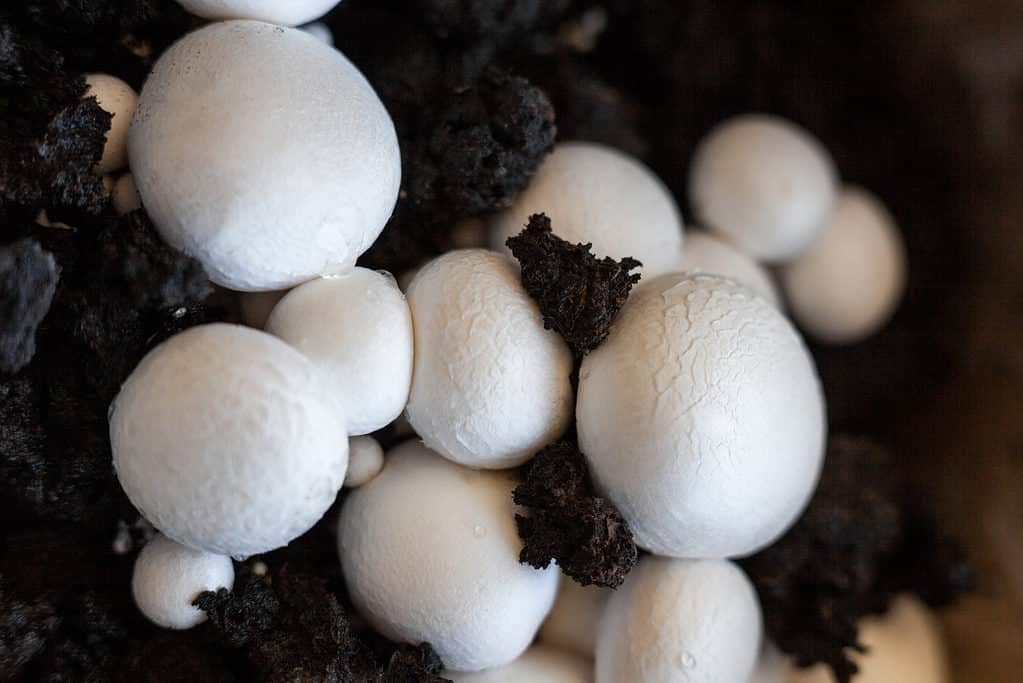
Young white mushrooms (
Agaricus bisporus).©rootstock/Shutterstock.com
White mushrooms are one of the most popular varieties of edible mushrooms. About 90 percent of the mushrooms consumed in the United States are white mushrooms. White mushrooms are native to Europe and North America, but are cultivated all over the world. These mushrooms are also called “Button Mushrooms” when they are at a young age. In fact, three of the most common mushrooms you will find in the store – button, cremini, and portobello – are actually the same species of mushroom at different stages of its life. This mushroom isn’t always white. It can be brown or white in young stages. Its mature state is usually brown. White mushrooms are saprotrophic and they are all edible, but they have a number of poisonous look-alikes.
3. Shaggy Mane (Coprinus comatus)

Young shaggy mane mushrooms are white in color.
©Rita Romanyshyn/Shutterstock.com
The shaggy mane is a common mushroom that grows natively in Europe and North America. This saprotrophic mushroom is edible when it is young. As the mushroom gets older, it changes color and then begins to auto-digest itself. Only eat shaggy mane when it is small, firm, and white. This mushroom grows in large numbers in lawns, disturbed areas, and meadows. It is also found along roadsides and in parking lots.
4. Oyster Mushroom (Pleurotus sp.)

Oyster mushrooms are a choice edible mushroom. This is a fantastic young specimen of the Oyster species
Pleurotus ostreatus.©iStock.com/Paola Iamunno
The oyster mushroom is a very common and very prized edible mushroom that grows all over the world, including in Europe, North America, China, India, and Japan. It’s important to note that there are 202 known species of oyster mushrooms, and all of them are edible. However, not all of them are white. Two common species of oyster mushrooms are white, off-white, or beige in color. These are the white oyster mushroom (Pleurotus ostreatus) and the phoenix oyster mushroom (Pleurotus pulmonarius).
5. Common Puffball (Lycoperdon perlatum)
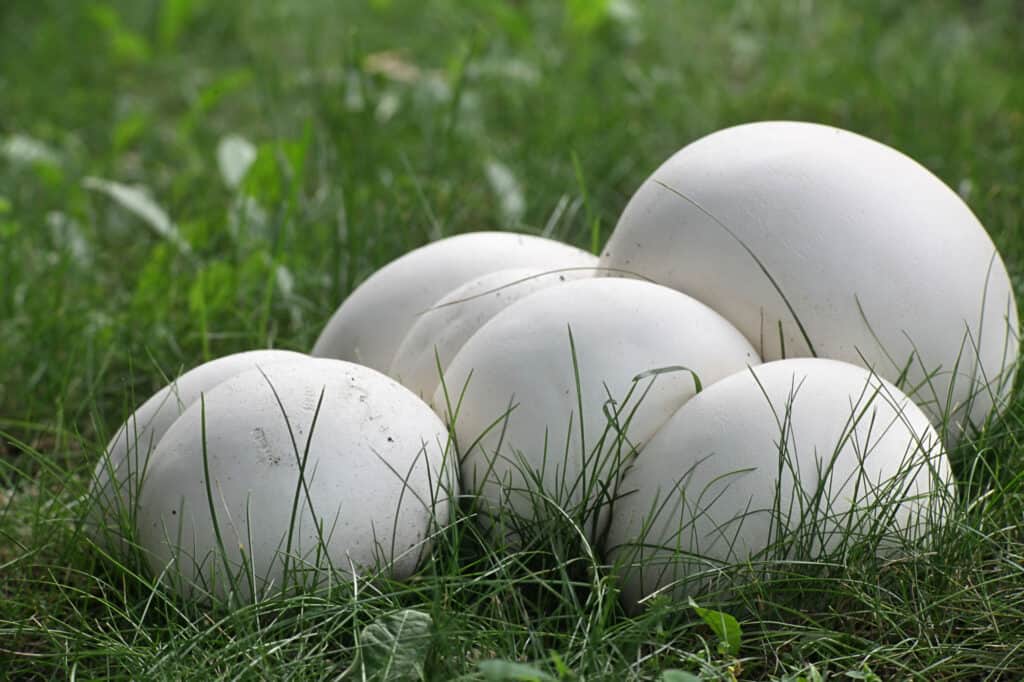
Most giant puffball mushrooms don’t taste like much, so they play well with other flavors.
©Henri Koskinen/Shutterstock.com
This saprotrophic mushroom grows all over the world, but particularly in Europe, North America, and China. The common puffball is completely white in color. There are several species of puffball – and all edible. They are distinctive mushrooms because they have no apparent stalk and no gills. They are, instead, smooth, white, and shaped like pears, eggs, or soccer balls. Be careful while foraging – puffballs have a couple of poisonous look-alikes, such as the common earthball (Scleroderma citrinum) and the young destroying angel (Amanita virosa).
6. Destroying Angel (Amanita sp.)
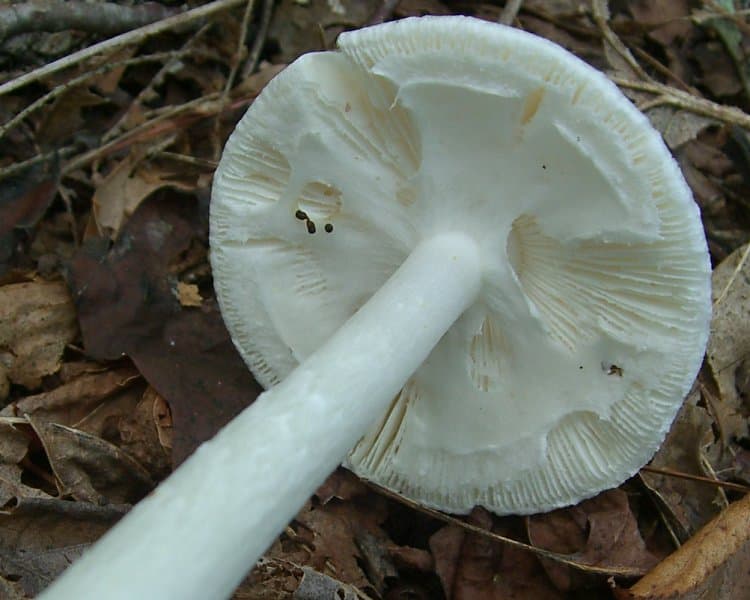
Destroying angel mushroom (
Amanita virosa).
The destroying angel is an Amanita mushroom. There are several species in this genus that go by the name “destroying angel”. Among them are the Amanita virosa, which is native to Europe, and the Amanita bisporigera. There are at least 14 species represented by the title, all of them poisonous. In fact, these mushrooms are among the most toxic mushrooms on the planet. Two of the most common North American types are the Amanita bisporigera and the Amanita ocreata. This is an incredibly common mushroom in North America and is often mistaken for the edible meadow mushroom (Agaricus campestris). Keep in mind that destroying angels are all white in color, including their gills.
7. Meadow Mushroom (Agaricus campestris)
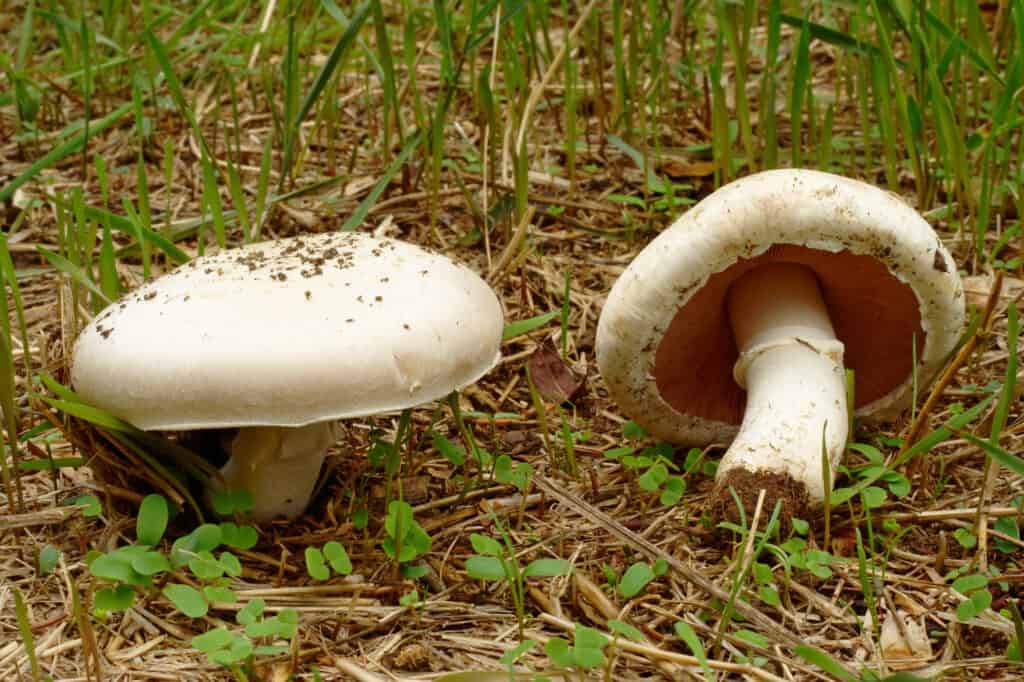
Meadow mushrooms are edible, but they can easily be confused with other highly toxic and dangerous mushrooms.
©iStock.com/fedsax
This saprotrophic mushroom grows in North America, Europe, northern Africa, New Zealand, and Asia. It is a choice edible mushroom that resemble the flavor and texture of white button mushrooms. It prefers to grow in grassy areas. The mushroom has a white cap that is sometimes scaled. The gills are light pink in youth, then brown and dark brown in maturity and decomposition. The stipe (stalk) of the mushroom is mostly white with a thin ring. This mushroom is often confused with another poisonous mushroom – the destroying angel (mentioned above). You can tell the difference easily by looking at the color of the gills on each mushroom. The destroying angel will always have white gills, unlike the pink/brown gills of the meadow mushroom.
8. White Dapperling (Leucoagaricus leucothites)

The white dapperling is often mistaken for a destroying angel.
©Chase G. Mayers, CC BY 4.0 , via Wikimedia Commons – Original / License
Our next white mushroom is the white dapperling. This mushroom is common in parts of North America, Europe, and the United Kingdom. This saprotrophic mushroom is considered to be edible, but is suspected to be slightly poisonous. Reported side effects after consumption include gastrointestinal distress. This all-white fungi deeply resembles the destroying angel, though seasoned foragers have some identification tricks to help them tell the difference. The best one is by the bulb. The destroying angel has an egg-like volva at the base, while dapperlings have a small, smooth, bulbous base.
9. False Parasol (Chlorophyllum molybdites)
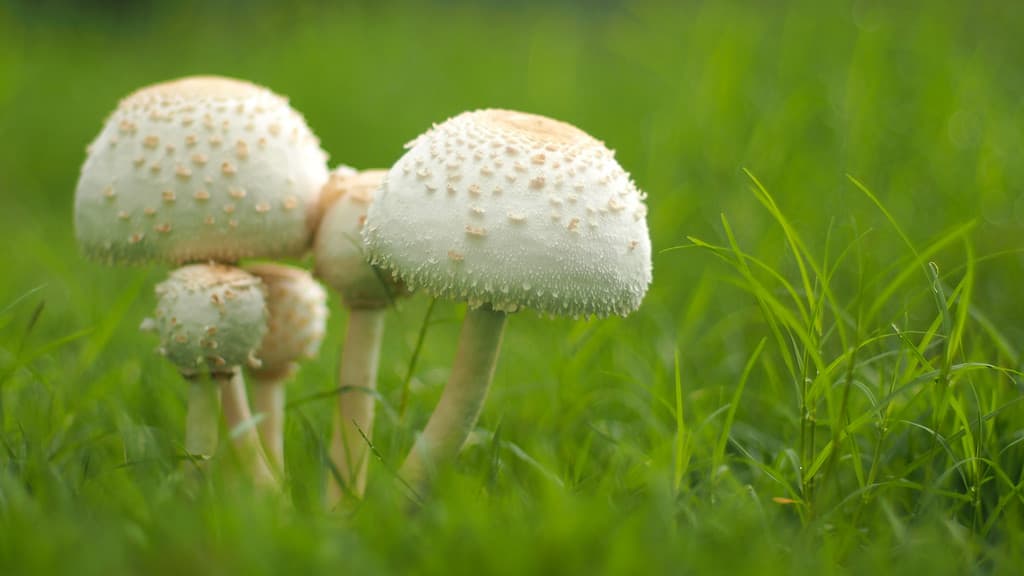
Don’t eat! The false parasol is toxic and will make you feel very ill.
©RilakkuMaxx/iStock via Getty Images
This toxic parasol mushroom grows in eastern North America, California, Australia, and Scotland. In North America, it has a reputation for being one of the most frequently eaten poisonous mushrooms. The cap is white or off-white with brown scales. The gills are white initially but turn green when mature. The stipe begins a white color, but sometimes becomes a pale reddish or brownish color. This is another saprotrophic fungus, and it prefers to grow in meadows, fields, and lawns. Ingestion of this mushroom causes gastrointestinal distress, including vomiting.
10. Porcelain Fungus (Oudemansiella mucida)

Porcelain fungus (Oudemansiella) on a dead tree trunk in the Netherlands.
©haarms/iStock via Getty Images
This one is fairly common in Europe and the United Kingdom. This white mushroom is saprotrophic or even weakly parasitic in some cases. It only grows on beech trees, and mostly on those that are dead or dying. This mushroom is edible if cleaned and cooked first. It has no known look-alikes, as it has a slimy top that greatly resembles porcelain. The entirety of the mushroom is white or sometimes slightly gray.
11. Frosty Bonnet (Mycena adscendens)

in the moss and lichen-covered bark of a wet tree.
©Matteo Sisi/iStock via Getty Images
The frosty bonnet is native to Europe and the United States. These tiny mushrooms are white or translucent white and very small. So small, in fact, that we do not know the edibility of them. Yes, this mushroom is tiny enough that picking enough of it to eat would not be worth the effort. They are saprotrophic and prefer to grow on fallen twins and other decomposing wood.
A Note on Edibility
Mushrooms can be delicious additions to our meals, but we must also take care when foraging for them. If you are looking for edible mushrooms, take care to use a number of references – including consulting with experts – when identifying your finds. If you are not completely sure the mushroom you’ve found is edible, do not eat it. Most poisonous mushrooms will only cause temporary distress, but there are a number of deadly fungi in the world. Eating unknown foraged mushrooms is dangerous, and identification should be taken very seriously. Please note that the above guide is for reference on species, not a guide on how to find edible mushrooms.
Summary
There are a lot more white mushrooms in the world, and it would be tough to put them all in one list. These 11 kinds of white mushrooms are a great beginners guide to white mushrooms all over the world. We’re going to summarize them in a table and then provide a short list of other white mushrooms.
| Mushroom | Distribution | Edibility |
|---|---|---|
| 1. Lion’s mane (Hericium sp.) | Asia, Europe, and North America | Edible, choice |
| 2. White mushroom (Agaricus bisporus) | Europe and North America, but cultivated worldwide | Edible, choice |
| 3. Shaggy mane (Coprinus comatus) | Europe and North America | Edible |
| 4. Oyster mushroom (Pleurotus sp.) | Europe, North America, China, India, and Japan | Edible, choice |
| 5. Common puffball (Lycoperdon perlatum) | Europe, North America, and China | Edible |
| 6. Destroying angel (Amanita sp.) | Europe and North America | Toxic |
| 7. Meadow mushroom (Agaricus campestris) | North America, Europe, northern Africa, New Zealand, and Asia | Edible |
| 8. White dapperling (Leucoagaricus leucothites) | North America, Europe, United Kingdom | Possibly edible, not preferred |
| 9. False parasol (Chlorophyllum molybdites) | North America, California, Australia, and Scotland | Toxic |
| 10. Porcelain fungus (Oudemansiella mucida) | Europe and the United Kingdom | Edible if cooked |
| 11. Frosty bonnet (Mycena adscendens) | Europe and the United States | Unknown |
Other White Mushrooms
- White beech mushroom (Hypsizygus sp.)
- Elm oyster mushroom (Hypsizygus ulmarius)
- Milk-white brittlegill (Russula delica)
- Angel wings (Pleurocybella porrigens)
- Twig parachute (Marasmiellus ramealis)
The photo featured at the top of this post is © barmalini/Shutterstock.com
The information presented on or through the Website is made available solely for general informational purposes. We do not warrant the accuracy, completeness, or usefulness of this information. Any reliance you place on such information is strictly at your own risk. We disclaim all liability and responsibility arising from any reliance placed on such materials by you or any other visitor to the Website, or by anyone who may be informed of any of its contents. None of the statements or claims on the Website should be taken as medical advice, health advice, or as confirmation that a plant, fungus, or other item is safe for consumption or will provide any health benefits. Anyone considering the health benefits of particular plant, fungus, or other item should first consult with a doctor or other medical professional. The statements made within this Website have not been evaluated by the Food and Drug Administration. These statements are not intended to diagnose, treat, cure or prevent any disease.
Thank you for reading! Have some feedback for us? Contact the AZ Animals editorial team.







